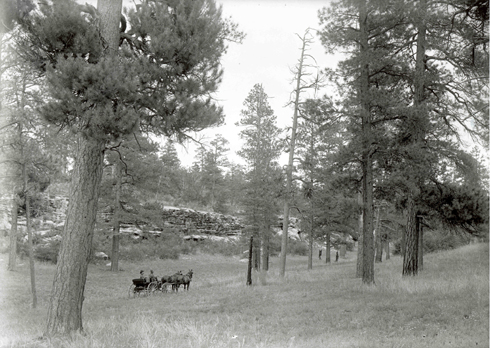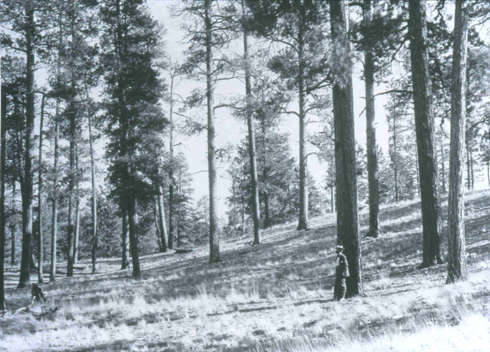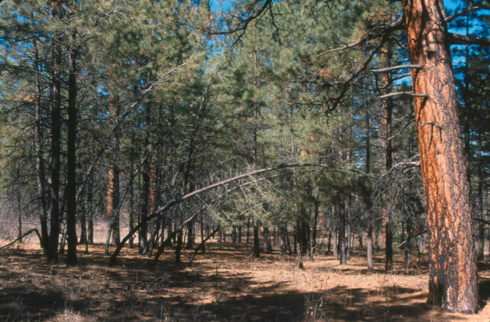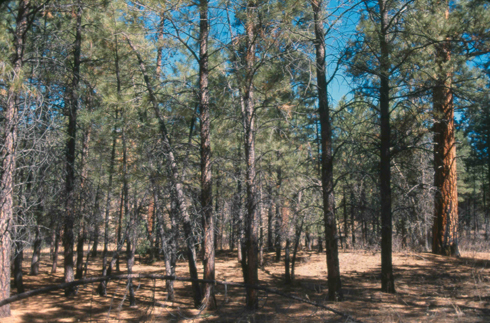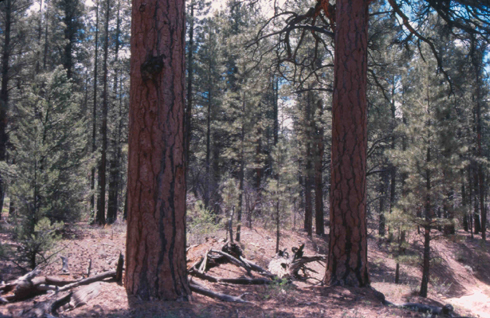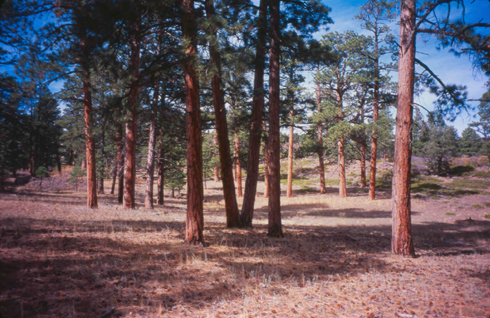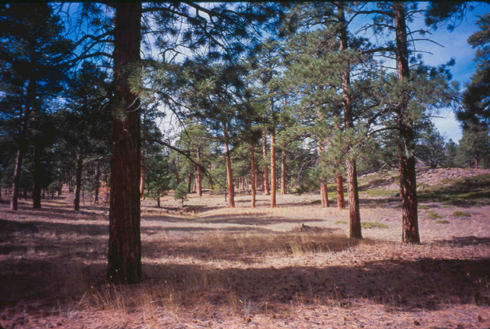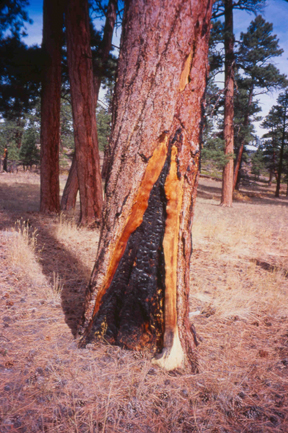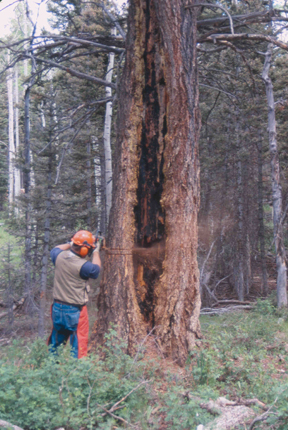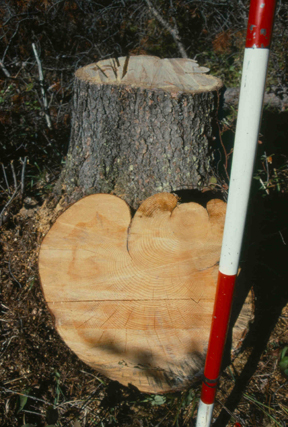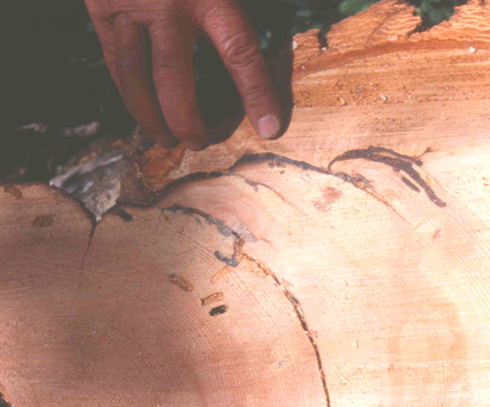The Forest Health Crisis: How Did We Get In This Mess?
Charles E. Kay. 2009. The Forest Health Crisis: How Did We Get In This Mess? Mule Deer Foundation Magazine No.26:14-21.
Dr. Charles E. Kay, Ph.D. Wildlife Ecology, Utah State University, is the author/editor of Wilderness and Political Ecology: Aboriginal Influences and the Original State of Nature [here], author of Are Lightning Fires Unnatural? A Comparison of Aboriginal and Lightning Ignition Rates in the United States [here], co-author of Native American influences on the development of forest ecosystems [here], and numerous other scientific papers.
Full text with photos (click on photos for larger images):
THE WEST is ablaze! Every summer large-scale, high-intensity crown fires tear through our public lands at ever increasing and unheard of rates. Our forests are also under attack by insects and disease. According to the national media and environmental groups, climate change is the villain in the present Forest Health Crisis and increasing temperatures, lack of moisture, and abnormally high winds are to blame. Unfortunately, nothing could be further from the truth.
The Sahara Desert, for instance, is hot, dry, and the wind blows, but the Sahara does not burn. Why? Because there are no fuels. Without fuel there is no fire. Period, end of story, and without thick forests there are no high-intensity crown fires. Might not the real problem then be that we have too many trees and too much fuel in our forests? The Canadians, for instance, have forest problems similar to ours but they do not call it a “Forest Health Crisis,” instead they call it a Forest Ingrowth Problem. The Canadians have correctly identified the issue, while we in the States have not. That is to say, the problem is too many trees and gross mismanagement by land management agencies, as well as outdated views of what is natural.
When Europeans first arrived in the West, ponderosa pine forests were open and park-like. You could ride everywhere on horseback or even in a horse and buggy, the forests were so open. On average there were only between 10 and 40 trees per acre with an understory of grasses, forbs, and shrubs. Extensive meadows were also common. In short, ideal mule dear habitat.
Photo 1 — A 1905 photograph of a ponderosa pine forest on the Kaibab in northern Arizona. It is amazing how parklike our pine forests once were. The forests were so open that you could travel virtually anywhere in a horse and buggy. Understory grasses, forbs, and shrubs were abundant. U.S. Geological Survey photo.
Photo 2 — A 1903 photograph of a ponderosa pine forest on the Coconino in northern Arizona. Note the park-like conditions and the men for scale, as well as the abundance of understory forage. Due to the openness of the forest, historically, crown fires never occurred, unlike conditions today. U.S. Forest Service photo.
Today, however, those same forests contain anywhere from 500 to 2,000 mostly smaller trees per acre. Travel on horseback is out of the question, and access by foot is even difficult. Many former meadows are now overgrown with trees. Understory forage production is approaching zero and our pine forests are becoming increasingly worthless as mule deer habitat.
Photos 3 and 4 — Modern examples of forest ingrowth on the Kaibab National Forest in northern Arizona. The elimination of native burning has allowed a proliferation of small trees. The stage is now set of a high-intensity crown fire. Understory forage production is non-existent. Photos by the author.
Photo 5 — Forest ingrowth on the Dixie National Forest in southern Utah. In the absence of frequent, low-intensity fires, small trees have proliferated setting the stage for a high-intensity crown fire, unlike historic conditions. Understory forage production is non-existent. Photo by the author.
The same thing has happened in other forest types, such as inland Douglas fir, pinyon-juniper, western oaks, sequoias, spruce-fir, and even coastal redwoods, among others. In southern Utah, 1,134 of the repeat photosets that I have made depict conifers and in 92% of those cases, conifers increased, often dramatically. The same is true of pinyon-juniper, which increased in 96% of 1,007 photosets. Every other repeat-photo study that has ever been done in the West has reported similar results. Trees, trees, and more trees. In some forests, such as lodgepole pine, mixed-severity and crown fires were common but not the 100,000 to 200,000 acre infernos we see today.
Why the change? Fire, or more correctly, the lack thereof. Paradoxically, if you want a healthy forest you have to burn it, and frequently. Because bark thickness increases with age, cool-burning surface fires easily kill seedlings and young conifers, but not larger trees. A few seedlings, by chance missed being burned and grew into the widely-spaced trees that greeted Europeans. So historically, western forests burned all the time but there were virtually none of the large-scale, high-intensity crown fires that are all too common today. Instead, frequent, low-intensity surface fires repeatedly thinned the forest preventing ingrowth and the heavy accumulation of fuels.
Photos 6 and 7 — A rare, heritage ponderosa pine forest in southern Utah. This is how ALL the West’s lower-elevation forests should look. A few widely spaced trees with abundant understory forage production. Photos by the author.
We know this because some trees were damaged, or scarred, by those early surface fires. Old fire scars are common in our western forests, and by cutting a slice out of those trees, sanding the cross-sections, and counting the growth-rings between individual fire-scars, we can determine how often that tree was damaged by fire in the past.
Photo 8 — A fire-scar on a ponderosa pine in southern Utah. Photo by the author.
Photo 9 — A Forest Service researcher chain-sawing a section from a fire-scarred Douglas fir in southern Utah. Photo by the author.
Photo 10 - - A fire scarred lodgepole pine from southern British Columbia. The tree began growth in 1847 and was scarred by fires in 1867, and 1890, but not in the last 120 years. Red and white survey pole in one foot increments for scale. Photo by the author.
Photo 11 - - Fire scars in a section from a Douglas fir on the Dixie National Forest in southern Utah. At least four earlier fires scarred this tree. Since the last fire in 1870, the tree has partially overgrown the earlier fire injury. Photo by the author.
By cross-dating scars from individual trees, we can also determine how often fire visited a given area. But even fire-history studies do not tell the whole story because not every fire, scarred every tree. Data from stands with known fire histories suggest that the actual rate of forest burning was anywhere from two to seven times more frequent than reported by standard fire-scar analysis. In many forests, the historical rate of burning was once every one to three years. Fire, fire, and more fire — but low-intensity surface fires, not the raging crown fires we see today. At present, it is difficult for the average person to imagine how our forests once appeared, the change has been so complete.
So why did the fires stop burning? European settlement, the establishment of national forests, the creation of the U.S. Forest Service, and the mistaken belief that all fires are bad. As historian Stephen Pyne chronicled in his book, Fire in America, in order to grow its budget and increase its political influence, the newly created Forest Service elevated fighting fires to the moral equivalent of war. All fires were evil and had to be suppressed at all costs. A few early scientists tried to tell the agency that this policy was misguided, but the Forest Service went to great lengths to suppress all dissent. As Dr. Pyne explained, this was called the light-burning controversy. For years, anyone who questioned federal fire policy had his or her career ruined by the Forest Service, as the agency sought to expand its empire. Science took a seat at the back of the bus, a bus driven by establishment dogma. Congress, by giving land management agencies a blank check when it came to fighting fires, only made things worse.
While it is easy to understand the connection between fire suppression, forest ingrowth, and today’s massive wildfires, it is harder to see the relationship between forest ingrowth and drought-killed trees, or forests ravaged by insects and disease, but the connection, nonetheless, is real. Trees in our western forests today are not being killed by drought, despite what you may have seen in the press. Recall that the original forests had only somewhere between 10 to 40 trees per acre, while today’s forests have from 500 to 2,000 trees per acres. Ten to forty, even big trees, use less water than 500 to 2,000 smaller trees. Large old trees that survived numerous droughts in the past are dying today because there is too much competition for limited soil moisture. If there were fewer stems per acre, individual trees would not die during periods of below average precipitation.
Drought-stressed trees are also more susceptible to insects and disease. So insects and diseases that were always found in our forests but at low or endemic levels, now increase to epidemic proportions. Some have even suggested that the smoke from low-intensity surface fires once kept forest diseases and insects in check. Native people in California, for example, cite insect and disease control as one reason why they repeatedly fired oak forests. Which brings us to another contentious issue, aboriginal burning — both inadvertent escaped campfires, and purposefully-set management fires.
Although the Forest Service is still largely in the fire suppression mode, the tide is slowly starting to change as fire-history studies accumulate, and as the results of the agency’s fire-suppression policy are seen in our forests. Many people now agree that fire is important for forest health, but they disagree about what, or who, started all those historical fires.
The prevailing view among fire ecologists, Forest Service officials, and environmentalists is that historically most fires were started by lightning and that aboriginal burning was unimportant. Anthropologists and a handful of scientists, however, paint an entirely different picture. Aboriginal burning ruled! This debate, unfortunately, has strong racist overtones.
Certain ecosystems in California, for instance, experience few lightning strikes and virtually no lightning-caused fires, yet fire-history studies indicate that those areas burned frequently in the past. Unless you want to invoke an extraterrestrial cause, all those early fires had to have been set by native people, who used fire to manage their environment and to make that environment more productive for humans. Anthropological studies have shown that native peoples in California had at least 70 specific reasons why they fired the vegetation. All this frequent, low-intensity burning also promoted biodiversity. That is to say, aboriginal people fully understood the beneficial use of fire. A fact acknowledged by fire ecologists, who work in these lightning-poor areas. So far so good.
However, in other parts of California, lightning and lightning-caused fires are more common and in those places, fire ecologists totally discount the importance of aboriginal burning. Apparently, some native people in California were astute enough to use fire to their advantage, while other indigenous groups were too backward to understand that connection and instead had to pray for lightning strikes to burn unwanted vegetation. Lest you think I exaggerate, I direct your attention to a recent book on Fire in California’s Ecosystems, where this is spelled out. One of the all too common racist codewords is “presettlement conditions,” when what the authors actually mean is pre-European settlement. They ignore the fact that this entire country has been settled for at least the last 12,000 years.
Environmentalists too are guilty of this fiction with outdated ideas such as wilderness. For instance, in a recent edited volume entitled, Fire, Native Peoples, and the Natural Landscape, the authors discounted the effects of aboriginal burning. “Ignitions by Indians were… probably numerically insignificant relative to lightning ignitions… [and] Indians were a small part of a large [western] wilderness, with a fire regime… essentially free of human influence for millennia.” A wilderness supposedly untouched by the hand man. Or so it is claimed. Interestingly, in the entire book there are no data on known lightning-ignition rates or potential aboriginal-ignition rates.
This led me to compile data on lightning-ignition rates for every National Forest in the United States. I then compared those data to potential aboriginal-ignition rates based on estimates of aboriginal populations and the number of both inadvertent and purposefully-set fires per indigenous person per year. Even at the lowest published estimate for the number of native people in the United States prior to European influence, and assuming that each native person only set one fire per year, potential aboriginal-ignition rates were 3 to 350 times greater than documented lightning-ignition rates. Using more realistic estimates of native populations, as well as the number of fires started per person per year, potential aboriginal-ignition rates were 270 to 35,000 times greater than known lightning-ignition rates. Clearly, lightning-caused fires have been largely irrelevant for at least the last 12,000 years. Instead, the dominant ecological force has been aboriginal burning.
In the scientific paper that I published on this, I went on to explain how aboriginal burning created both western and eastern forest communities heretofore thought to have been “untouched by the hand of man.” There were no unnamed mountains, there were no unnamed rivers, and there was no wilderness, except in the imagination of Europeans. Needless to say, this is not what the back-to-nature folks wish to hear because to return our forests to the conditions that once existed, which appears to be the standard under ecosystem management, more, not less, active management is needed. In addition, due to forest ingrowth and the build-up of forest fuels, you cannot just drop the match, as that would only result in the destruction of our remaining heritage forests. Instead, our forests need to be mechanically thinned, and fuel loads reduced, before fire is reintroduced.
Finally, there is also the problem that environmentalists and their allies in the scientific community have started to cook the books in support of the idea that large-scale, crown fires are normal, and therefore should be encouraged. I am sure you all remember that in 1988 wildfires burned a large part of the Yellowstone ecosystem. The Park Service and its friends in the environmental community claim that those fires were normal and not outside the range of natural variation. The agency presented fire-history data by 50 year intervals to support this contention. And yes, when grouped in 50 year intervals, the 1988 wildfires do not appear to be out of place.
Dr. Tom Bonnicksen of Texas A&M University, however, obtained the original data used by the Park Service but graphed those data by 10-year intervals, not the 50 year-time periods used by the agency. And lo and behold an entirely different pattern emerged. The park’s forests stopped burning in 1870, which is about when native people were forced from the area and meadow burning ceased. Then there were few fires of any size for the next 118 years. In addition, more area burned in 1988, than in any 10-year interval over the last 400 years.
The exact same data, but an entirely different interpretation. This, in the profession, is what is called shading-the-truth, or lying, with statistics, graphs being a form of numerical analysis. Native Americans no longer set fires in the park, the park suppressed fires and let fuels build-up for over 100 years, before the agency switched to a let-burn policy. Then under extreme weather conditions, wildfires burned more in one season than in any 10 year period back as far as fire-history data are available. Dr. Bonnicksen later published a book, America’s Ancient Forests, which explains in more detail how our forests have been mismanaged and the public deceived. We clearly need to drive a wooden stake through the heart of Smokey Bear and outdated ideas about the original state of nature.
Dr. Jack Ward Thomas, former Chief of the Forest Service tells of a conversation he had with a U.S. Senator. The Senator suggested to Dr. Thomas that we needed to rely on science in managing our nation’s forests. Jack replied, “What a novel idea, Senator, perhaps we ought to try it once.”
Perhaps we ought to try it once! Because what we have done up until now certainly has not worked. Scientific management, what a novel idea. Historically, our forests were CREATED by the hand of man and therefore need to be maintained by active management. Letting nature take its course will only lead to raging infernos, watershed destruction, and the loss of biodiversity, not to mention lost lives and property. Conserving forest habitat for mule deer is of little importance if those lands are not properly managed. Management is NOT a dirty word, as some people would have you believe. Instead, it is an absolute biological necessity.
For those who would like more information on native burning, I suggest Dr. Kat Anderson’s recent book entitled Tending the Wild: Native American Knowledge and the Management of California’s Natural Resources, as well as Dr. Omer Stewart’s posthumous book, Forgotten Fires: Native Americans and the Transient Wilderness.
